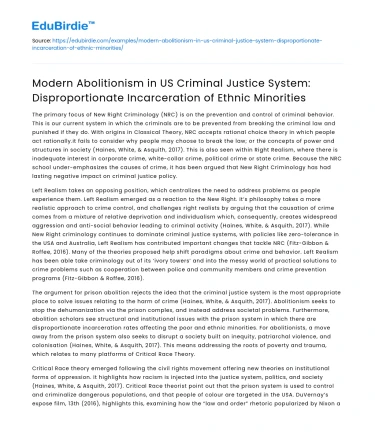The primary focus of New Right Criminology (NRC) is on the prevention and control of criminal behavior. This is our current system in which the criminals are to be prevented from breaking the criminal law and punished if they do. With origins in Classical Theory, NRC accepts rational choice theory in which people act rationally.it fails to consider why people may choose to break the law; or the concepts of power and structures in society (Haines, White, & Asquith, 2017). This is also seen within Right Realism, where there is inadequate interest in corporate crime, white-collar crime, political crime or state crime. Because the NRC school under-emphasizes the causes of crime, it has been argued that New Right Criminology has had lasting negative impact on criminal justice policy.
Left Realism takes an opposing position, which centralizes the need to address problems as people experience them. Left Realism emerged as a reaction to the New Right. It’s philosophy takes a more realistic approach to crime control, and challenges right realists by arguing that the causation of crime comes from a mixture of relative deprivation and individualism which, consequently, creates widespread aggression and anti-social behavior leading to criminal activity (Haines, White, & Asquith, 2017). While New Right criminology continues to dominate criminal justice systems, with policies like zero-tolerance in the USA and Australia, Left Realism has contributed important changes that tackle NRC (Fitz-Gibbon & Roffee, 2016). Many of the theories proposed help shift paradigms about crime and behavior. Left Realism has been able take criminology out of its ‘ivory towers’ and into the messy world of practical solutions to crime problems such as cooperation between police and community members and crime prevention programs (Fitz-Gibbon & Roffee, 2016).
Save your time!
We can take care of your essay
- Proper editing and formatting
- Free revision, title page, and bibliography
- Flexible prices and money-back guarantee
The argument for prison abolition rejects the idea that the criminal justice system is the most appropriate place to solve issues relating to the harm of crime (Haines, White, & Asquith, 2017). Abolitionism seeks to stop the dehumanization via the prison complex, and instead address societal problems. Furthermore, abolition scholars see structural and institutional issues with the prison system in which there are disproportionate incarceration rates affecting the poor and ethnic minorities. For abolitionists, a move away from the prison system also seeks to disrupt a society built on inequity, patriarchal violence, and colonisation (Haines, White, & Asquith, 2017). This means addressing the roots of poverty and trauma, which relates to many platforms of Critical Race Theory.
Critical Race theory emerged following the civil rights movement offering new theories on institutional forms of oppression. It highlights how racism is injected into the justice system, politics, and society (Haines, White, & Asquith, 2017). Critical Race theorist point out that the prison system is used to control and criminalize dangerous populations, and that people of colour are targeted in the USA. DuVernay’s expose film, 13th (2016), highlights this, examining how the “law and order” rhetoric popularized by Nixon and Reagan is used to justify violence and oppression of black communities. African-American men have a significantly higher percentage of lifetime likelihood of imprisonment – one in 17 white males will do prison time, compared to only one in three African-American males (DuVernay, 2016). According to Critical Race Theory, this racial disparity in the criminal justice system exists, as the proportion of a racial or ethnic group, within the control of the system, is greater than the proportion of such groups in the general population. Furthermore, the disproportionate incarceration rates, exemplified in DuVernay’s 13th (2016), of minority communities are continuing the cycle of intergenerational oppression – the mass incarceration problem in the USA is argued to be an extension of slavery. To many Critical Race theorists, mass incarceration is viewed as a manifestation of racial inequality; abolitionism would be an important element in addressing racial biases in the criminal justice system.
For critical postmodern criminologists, a starting point is the focus on the role of language, as they contend that language structures thought. Language here refers to spoken discursive language. Postmodernism emerged as a design movement eventually moving into a philosophical theory concerned with the properties of the literary text, meaning, and reading (Haines, White, & Asquith, 2017). Postmodernism holds that there is no objective truth or reality. Truth and reality are often defined as the state of things as they actually exist, as opposed to an idealistic or notional idea of them. However, according to Postmodernism these are subjective concepts unique to each of us, we have our various perceptions but never the ‘truth’ hence we can not attain a fully unprejudiced view. Our ways of talking don’t neutrally reflect our world, identities and social relationships, but rather play an active role in creating and changing them. For Postmodern criminologists these subjectivities exist only as social labels, as social categories and are socially defined (Haines, White, & Asquith, 2017). Thus language, and more broadly discourse, influences thought, and in criminology there can be a ‘symbolic violence’ in language, discourse and symbols. To many postmodern criminologists a solution to this is by the development of a replacement discourses that will undercut the power of the dominant languages that regulate and discipline the lives of alienated collectives. Black Lives Matter exemplifies this. The campaign seeks to withdraw authority from the dominant policing discourse in the USA, which has woven history, political conversation and the use of the media to construct and frame African-Americans as inherently criminal (Haines, White, & Asquith, 2017). According to postmodernist criminology, the discourse is dominant, exclusive, and exaggerates narrowly defined rules to the exclusion of others. The postmodern campaign challenges the hegemonic discourses with an inclusive replacement discourse that will assist in shifting social paradigms and resulting power structures.






 Stuck on your essay?
Stuck on your essay?

